Abstract
Three pigeons pecked for food in an experiment in which reinforcements were arranged for responses terminating sequences of interresponse times. Each reinforced interresponse time belonged to a class extending either from 1.0 to 2.0 sec (class A) or from 3.0 to 4.5 sec (class B). Reinforcements were arranged by a single variable-interval schedule and a random device that assigned each reinforcement to one of four sequences of two successive interresponse times: AA, AB, BA, or BB. Throughout the experiment, half of the reinforcements were delivered for interresponse times in class A and half for those in class B. Over conditions, the interresponse time preceding a reinforced interresponse time always, half of the time, or never, belonged to class A. The duration of the interresponse time preceding a reinforced one had a pronounced effect on response patterning. It also had a pronounced effect on the overall response probability, which was highest, intermediate, and lowest, when the interresponse time preceding a reinforced interresponse time always, half of the time, or never, belonged to class A, respectively. In no case were successive interresponse times independent, so that overall response probability was not representative of momentary response probabilities.
Full text
PDF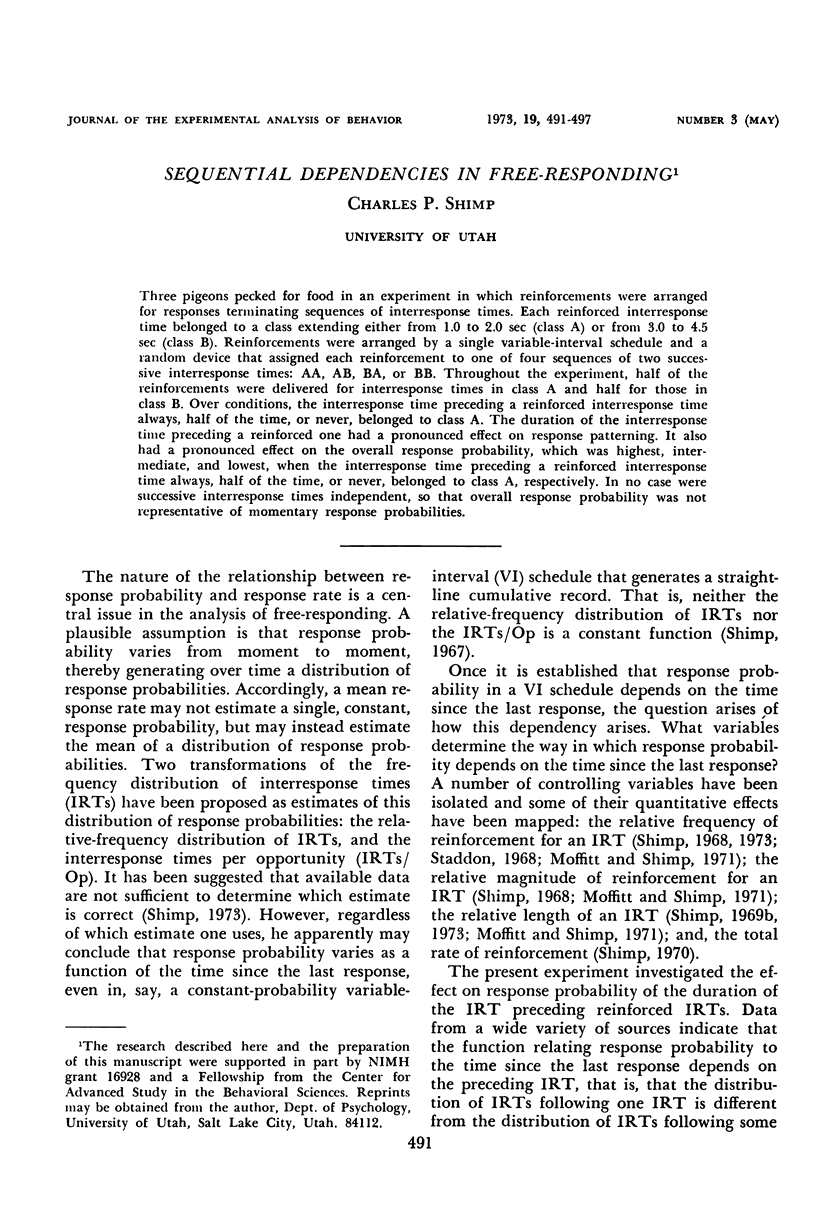

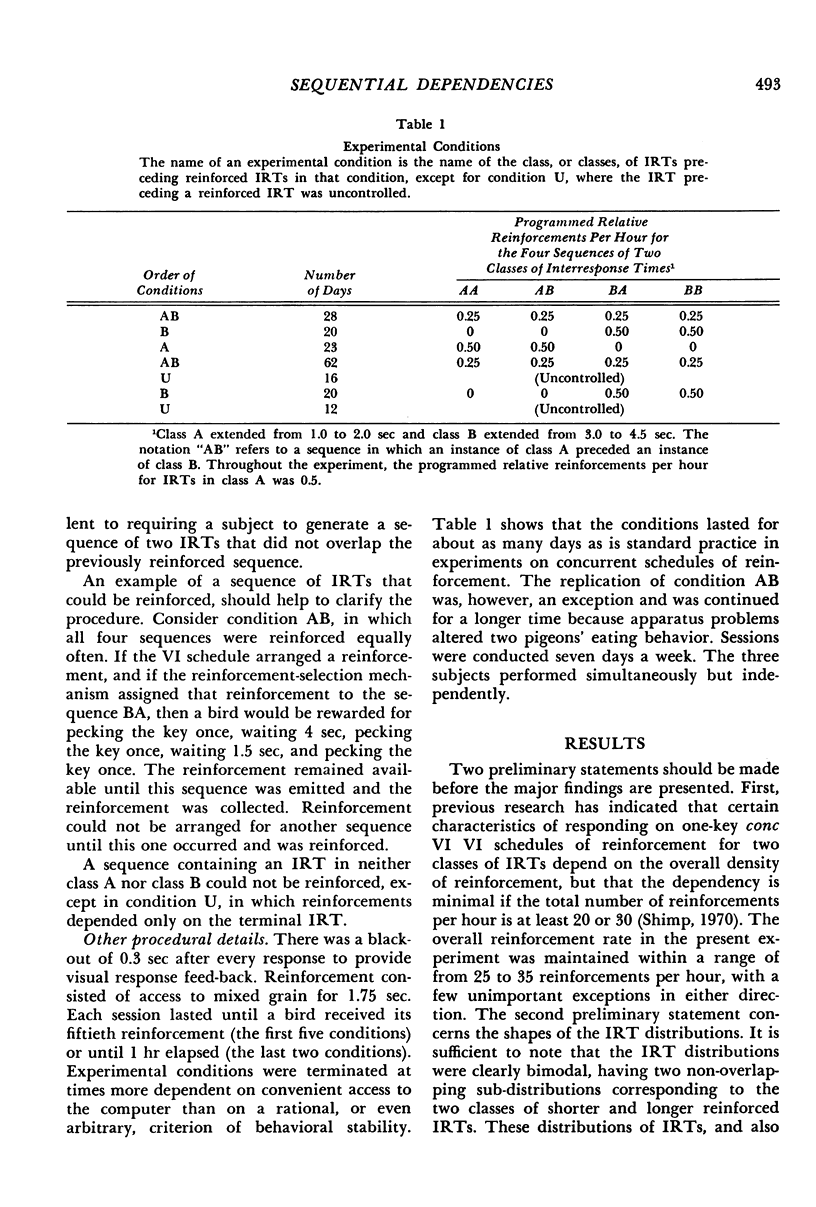

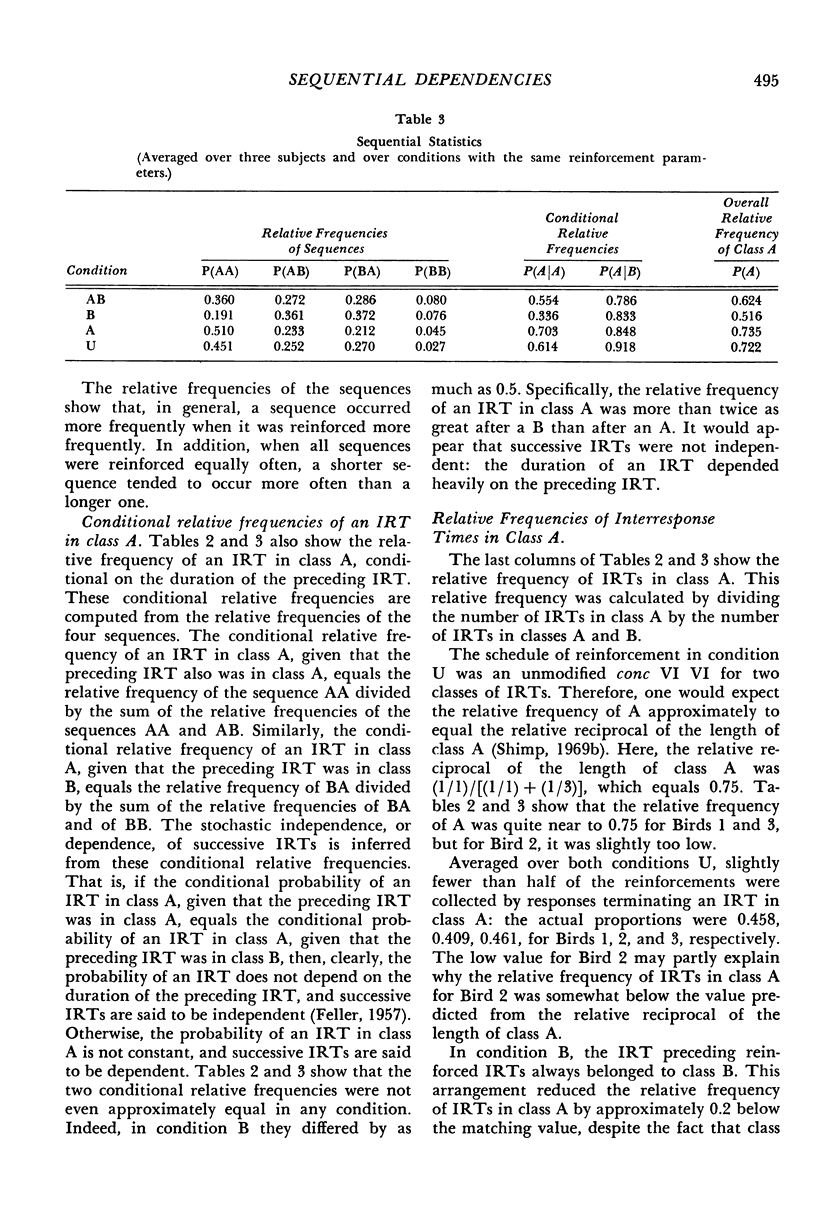
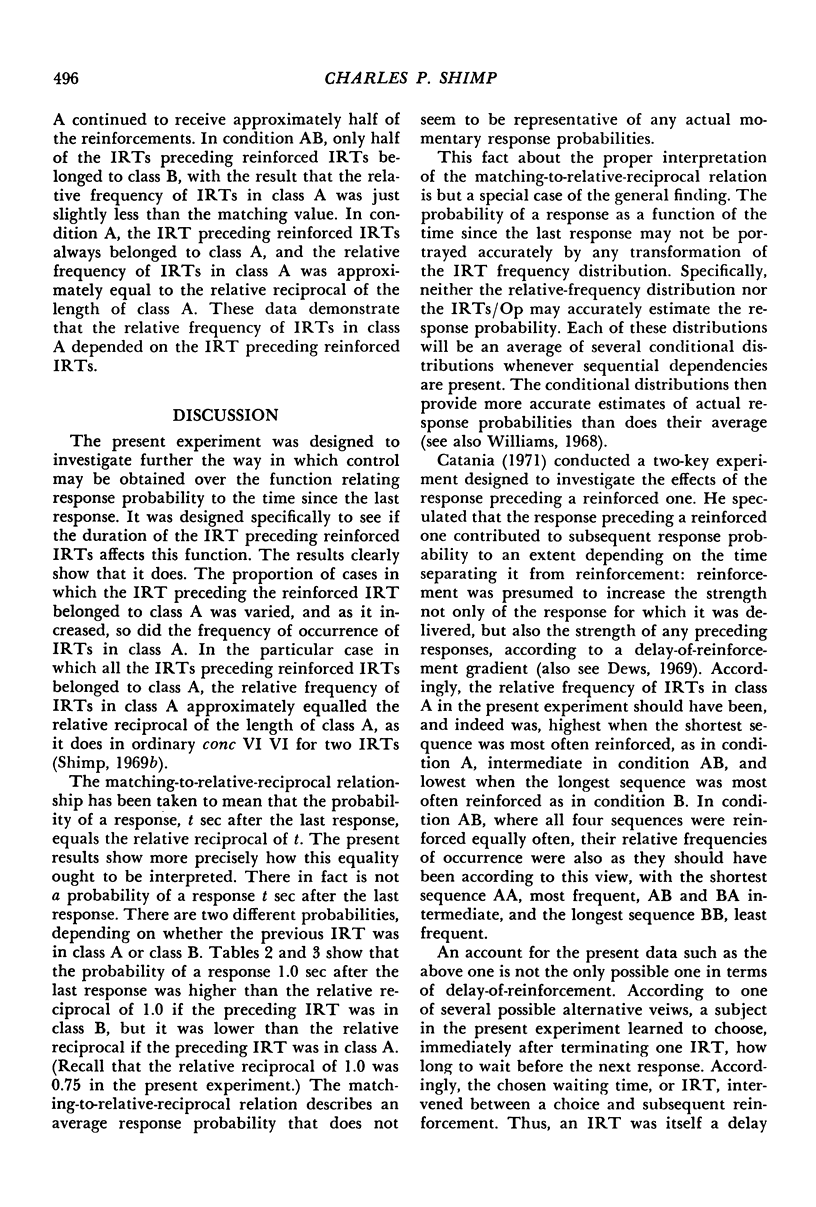
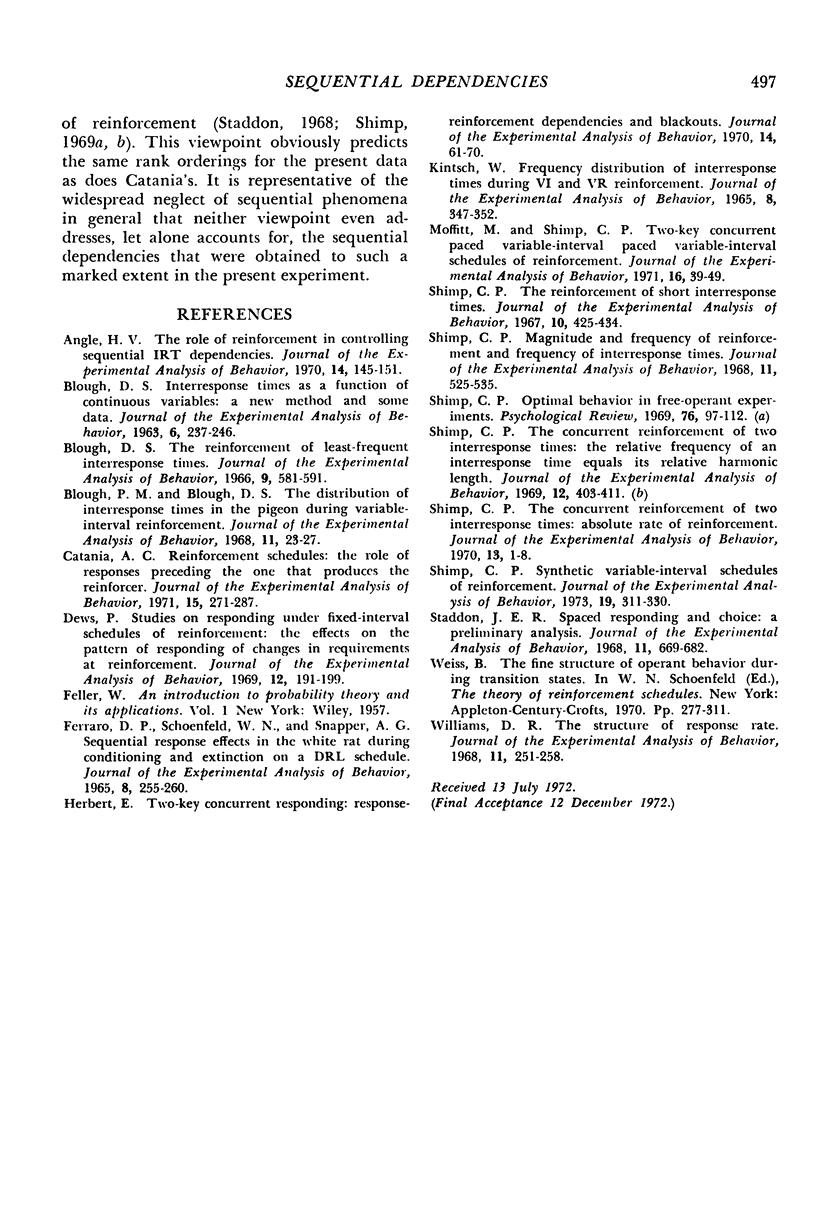
Selected References
These references are in PubMed. This may not be the complete list of references from this article.
- Angle H. V. The role of reinforcement in controlling sequential IRT dependencies. J Exp Anal Behav. 1970 Sep;14(2):145–151. doi: 10.1901/jeab.1970.14-145. [DOI] [PMC free article] [PubMed] [Google Scholar]
- Blough D. S. Interresponse time as a function of continuous variables: a new method and some data. J Exp Anal Behav. 1963 Apr;6(2):237–246. doi: 10.1901/jeab.1963.6-237. [DOI] [PMC free article] [PubMed] [Google Scholar]
- Blough D. S. The reinforcement of least-frequent interresponse times. J Exp Anal Behav. 1966 Sep;9(5):581–591. doi: 10.1901/jeab.1966.9-581. [DOI] [PMC free article] [PubMed] [Google Scholar]
- Blough P. M., Blough D. S. The distribution of interresponse times in the pigeon during variable-interval reinforcement. J Exp Anal Behav. 1968 Jan;11(1):23–27. doi: 10.1901/jeab.1968.11-23. [DOI] [PMC free article] [PubMed] [Google Scholar]
- Catania A. C. Reinforcement schedules: the role of responses preceding the one that produces the reinforcer. J Exp Anal Behav. 1971 May;15(3):271–287. doi: 10.1901/jeab.1971.15-271. [DOI] [PMC free article] [PubMed] [Google Scholar]
- FERRARO D. P., SCHOENFELD W. N., SNAPPER A. G. SEQUENTIAL RESPONSE EFFECTS IN THE WHITE RAT DURING CONDITIONING AND EXTINCTION ON A DRL SCHEDULE. J Exp Anal Behav. 1965 Jul;8:255–260. doi: 10.1901/jeab.1965.8-255. [DOI] [PMC free article] [PubMed] [Google Scholar]
- Herbert E. W. Two-key concurrent responding: response-reinforcement dependencies and blackouts. J Exp Anal Behav. 1970 Jul;14(1):61–70. doi: 10.1901/jeab.1970.14-61. [DOI] [PMC free article] [PubMed] [Google Scholar]
- KINTSCH W. FREQUENCY DISTRIBUTION OF INTERRESPONSE TIMES DURING VI AND VR REINFORCEMENT. J Exp Anal Behav. 1965 Sep;8:347–352. doi: 10.1901/jeab.1965.8-347. [DOI] [PMC free article] [PubMed] [Google Scholar]
- Moffitt M., Shimp C. P. Two-key concurrent paced variable-interval paced variable-interval schedules of reinforcement. J Exp Anal Behav. 1971 Jul;16(1):39–49. doi: 10.1901/jeab.1971.16-39. [DOI] [PMC free article] [PubMed] [Google Scholar]
- Shimp C. P. Magnitude and frequency of reinforcement and frequencies of interresponse times. J Exp Anal Behav. 1968 Sep;11(5):525–535. doi: 10.1901/jeab.1968.11-525. [DOI] [PMC free article] [PubMed] [Google Scholar]
- Shimp C. P. Synthetic variable-interval schedules of reinforcement. J Exp Anal Behav. 1973 Mar;19(2):311–330. doi: 10.1901/jeab.1973.19-311. [DOI] [PMC free article] [PubMed] [Google Scholar]
- Shimp C. P. The concurrent reinforcement of two interresponse times: the relative frequency of an interresponse time equals its relative harmonic length. J Exp Anal Behav. 1969 May;12(3):403–411. doi: 10.1901/jeab.1969.12-403. [DOI] [PMC free article] [PubMed] [Google Scholar]
- Shimp C. P. The reinforcement of short interresponse times. J Exp Anal Behav. 1967 Sep;10(5):425–434. doi: 10.1901/jeab.1967.10-425. [DOI] [PMC free article] [PubMed] [Google Scholar]
- Staddon J. E. Spaced responding and choice: a preliminary analysis. J Exp Anal Behav. 1968 Nov;11(6):669–682. doi: 10.1901/jeab.1968.11-669. [DOI] [PMC free article] [PubMed] [Google Scholar]


